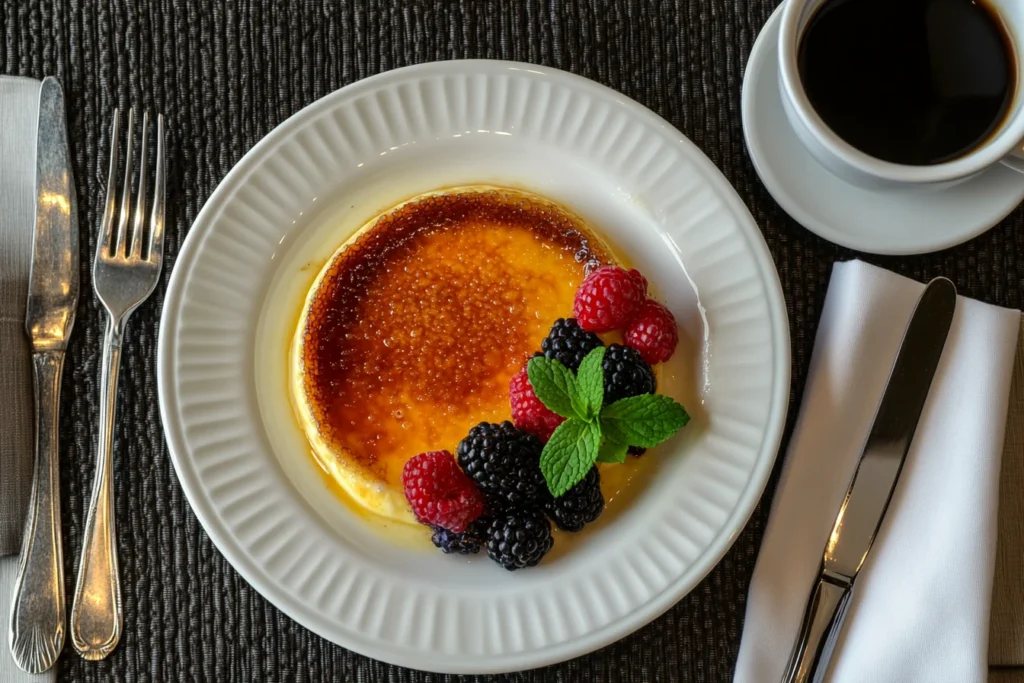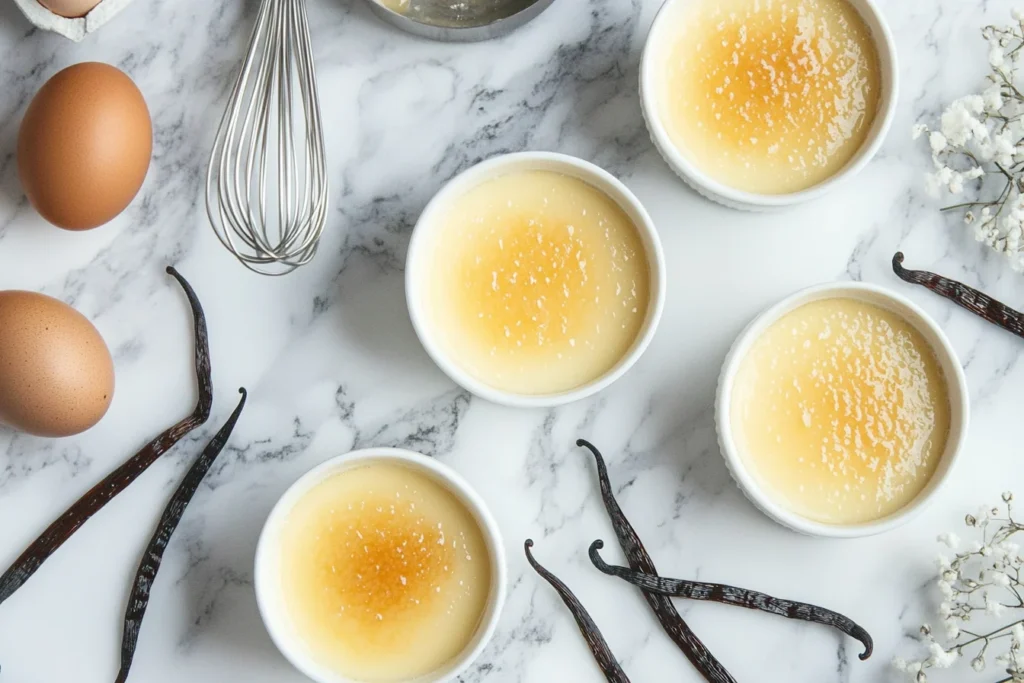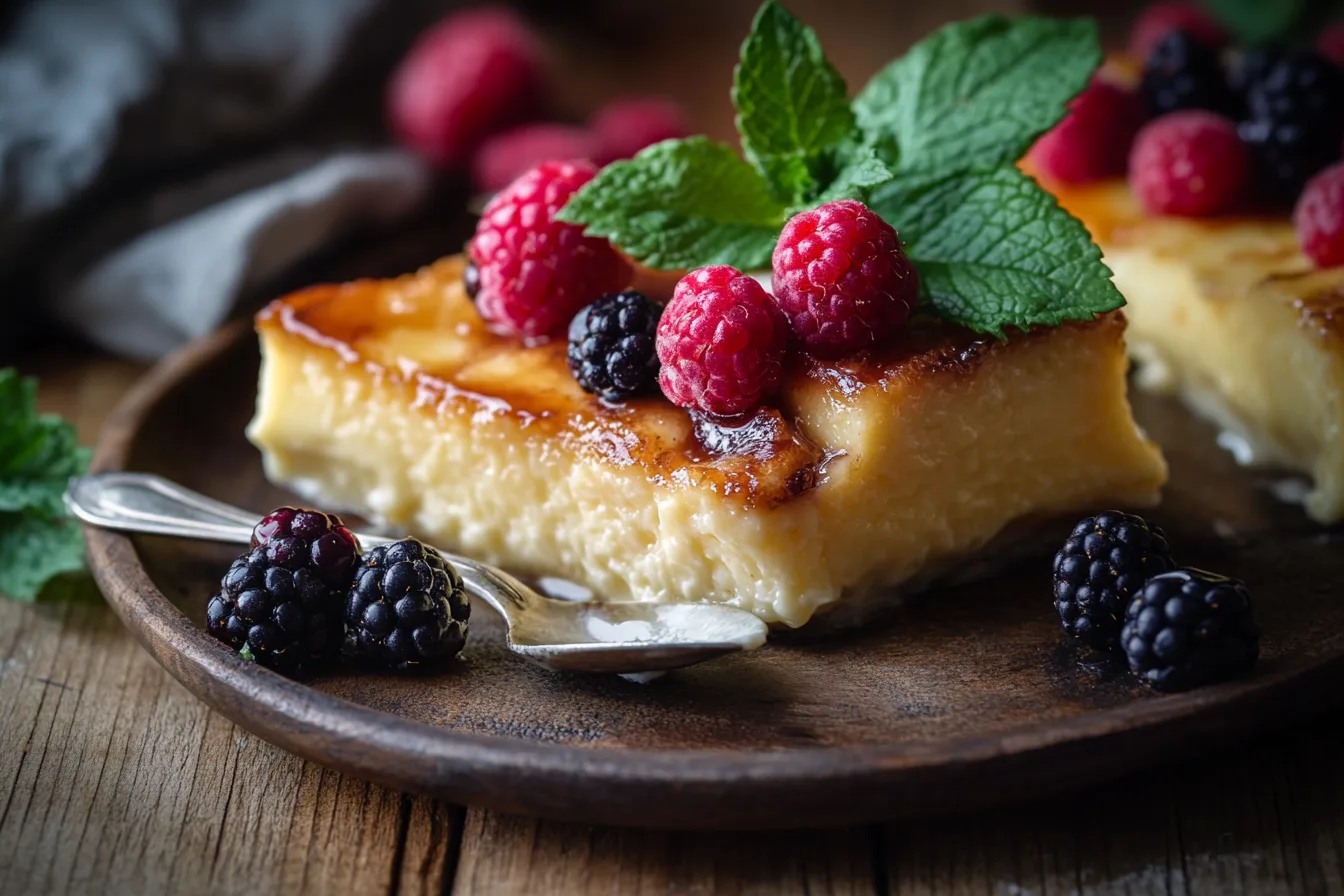Introduction
Crème brûlée is a dessert that’s been delighting taste buds for centuries. Known for its irresistible combination of a crackling caramelized sugar crust and velvety custard base, it’s a dessert that’s equal parts luxurious and approachable. But what does crème brûlée taste like? Is it just about sweetness, or does it have a more nuanced profile? In this article, we’ll dive deep into its flavors, textures, and how it compares to similar desserts, while also exploring its origins and the magic behind making it at home.
Understanding Crème Brûlée
The Origins and Cultural Significance of Crème Brûlée
Crème brûlée, which translates to “burnt cream” in French, has its roots in European culinary history. Though the French claim it as their own, some argue it first appeared in England as “Trinity Cream” or in Spain as crema catalana. Despite the debate, its place in French gastronomy is undisputed, often served in fine dining establishments to signify indulgence.
This custard dessert embodies the essence of simplicity—made from just a handful of ingredients—yet its preparation and presentation elevate it to a gourmet level. Its silky custard is contrasted by a thin, caramelized sugar layer that’s torched to perfection, creating a textural harmony that has become synonymous with culinary excellence.
A Breakdown of Its Core Ingredients
At its heart, crème brûlée is a custard. Its base is made from egg yolks, heavy cream, sugar, and vanilla, which give it its rich and creamy consistency. The caramelized sugar topping is achieved by sprinkling granulated sugar over the custard and using a blowtorch or broiler to melt and crisp it up.
Each ingredient contributes something unique:
- Egg yolks provide a luxurious, creamy texture.
- Heavy cream lends richness and a smooth mouthfeel.
- Vanilla extract infuses the custard with a fragrant, floral sweetness.
- Sugar adds sweetness and forms the signature crunchy topping.
Together, these ingredients create a dessert that’s simple yet sophisticated, making it beloved across cultures.
Flavor Profile of Crème Brûlée
The Sweet and Caramelized Notes
When asking, “What does crème brûlée taste like?”, the first answer that comes to mind is its sweet, caramelized flavor. The top layer, a thin crust of torched sugar, provides a smoky-sweet taste that’s incredibly satisfying. It’s this caramelization process that adds a depth of flavor reminiscent of roasted marshmallows or butterscotch.
The sweetness isn’t cloying but balanced by the creamy custard below. This dual-layer experience makes crème brûlée stand out among desserts. The toasty, almost nutty notes of the crust contrast beautifully with the soft custard, creating an exciting interplay of flavors.
For tips on achieving the perfect caramelization, visit The Secret to Crème Brûlée.
The Richness of Custard and Subtle Vanilla Undertones
The custard base of crème brûlée is where its elegance truly shines. Made from a simple mixture of heavy cream, egg yolks, and sugar, this custard boasts a richness that feels indulgent but not overwhelming. Infused with vanilla, it delivers a warm, aromatic flavor that elevates the dessert’s profile.
Some variations might include hints of citrus zest, almond, or even lavender, but the classic vanilla custard remains a favorite. Its mellow sweetness acts as the perfect counterpoint to the boldness of the caramelized topping.
This harmonious blend of textures and flavors is why crème brûlée is celebrated worldwide as a quintessential French dessert.
Texture and Mouthfeel
The Perfect Crunch of Caramelized Sugar
The textural contrast is perhaps the most distinctive feature of crème brûlée. The caramelized sugar layer, created by torching granulated sugar until it hardens, provides an audible crack when broken with a spoon. This brittle top layer offers not just a satisfying sound but also a delightful crunch that enhances every bite.
The technique behind achieving this perfect crust requires skill and precision. Too much heat, and the sugar burns; too little, and it remains gritty. Once mastered, this crispy layer becomes an integral part of the crème brûlée experience.
Creamy Custard Base: A Contrast of Textures
Beneath the crunchy surface lies the polar opposite—a creamy, silky custard. This soft base melts in your mouth, offering a velvety texture that contrasts with the caramelized topping. It’s this interplay between hard and soft that makes crème brûlée so irresistible.
The custard’s consistency is key. It shouldn’t be runny or overly firm; instead, it should hold its shape while maintaining a smooth, pudding-like quality. Each bite feels like a blend of luxury and comfort, making this dessert truly one of a kind.
For a unique twist on textures, explore the recipe for Crab Brûlée, which adds a savory element to the traditional dessert.
Crème Brûlée to Similar Desserts
Crème Brûlée vs. Flan: Key Differences
When comparing crème brûlée to flan, the differences start with the texture and flavor profiles. While both desserts feature a custard base, flan is often topped with a syrupy caramel layer instead of the crispy, caramelized sugar crust of crème brûlée. This results in a softer top for flan and a more pronounced crunch for crème brûlée.
Flan’s custard tends to be lighter and more gelatinous due to its inclusion of whole eggs, compared to the rich and creamy consistency of crème brûlée. If you’ve ever wondered, “What does crème brûlée taste like compared to flan?”, the answer lies in its luxurious vanilla notes and distinct textural contrast.
For more ideas on creating custard-based desserts, consider exploring the variety of recipes available on Medium Recipes.
Crème Brûlée vs. Panna Cotta: Texture and Flavor Contrasts
Panna cotta, an Italian dessert, differs significantly from crème brûlée in both preparation and taste. While crème brûlée is baked to achieve its creamy texture, panna cotta is set with gelatin, resulting in a firmer, more jiggly consistency. Flavor-wise, panna cotta leans toward light and refreshing, often featuring fruit or citrus infusions, unlike the deep, caramelized tones of crème brûlée.
The defining feature of crème brûlée is its burnt sugar topping, which panna cotta lacks. This crunchy element elevates crème brûlée into a category of its own, making it the preferred choice for those who love a balance of soft and crispy textures.
Serving and Enjoying Crème Brûlée

Traditional Serving Methods and Pairings
Crème brûlée is typically served in small, shallow ramekins, allowing for an even caramelized top and perfect custard-to-crust ratio. It’s best enjoyed fresh, with the sugar crust still warm and crunchy, while the custard remains cool and creamy.
Pairing crème brûlée with complementary flavors can enhance the experience. Fresh berries, like raspberries or strawberries, add a pop of tartness, balancing the dessert’s sweetness. A dollop of whipped cream or a sprig of mint can elevate the presentation while adding a refreshing element.
Tips for Enhancing the Crème Brûlée Experience
To take your crème brûlée to the next level, experiment with infused flavors. Vanilla bean is classic, but alternatives like lavender, orange zest, or even a splash of liqueur can add unique twists. Additionally, ensuring the custard is properly chilled before caramelizing the sugar will create the best textural contrast.
If you’d like to try unique variations, such as savory crème brûlée, check out recipes like Crab Brûlée for inspiration.
How to Make Crème Brûlée at Home

Key Tools and Ingredients You’ll Need
Making crème brûlée at home is simpler than it looks, provided you have the right tools and ingredients. First and foremost, you’ll need shallow ramekins to create the perfect custard-to-crust ratio. A kitchen blowtorch is essential for caramelizing the sugar, although a broiler can work in a pinch. A baking dish and some hot water for a water bath (bain-marie) are also crucial for ensuring even cooking.
For the ingredients, you’ll only need a handful of staples:
- Heavy cream for richness and smoothness.
- Egg yolks to create that silky custard texture.
- Granulated sugar for both the custard and the caramelized topping.
- Vanilla extract or, for a more authentic flavor, a scraped vanilla bean.
Having these essentials ready makes the process straightforward and fun.
Step-by-Step Guide for Beginners
- Prepare the custard base: Whisk the egg yolks and sugar until pale, then heat the cream with the vanilla. Slowly temper the cream into the egg mixture to avoid scrambling.
- Bake in a water bath: Pour the mixture into ramekins and place them in a baking dish. Add hot water to the dish until it reaches halfway up the sides of the ramekins. Bake at 325°F (160°C) until the custard is set but still slightly jiggly.
- Chill the custard: Allow the custards to cool at room temperature, then refrigerate for at least two hours (or overnight) to let the flavors meld.
- Caramelize the sugar: Just before serving, sprinkle an even layer of sugar on top and use a blowtorch to create a crispy, caramelized crust.
The result? A dessert that perfectly embodies the question, What does crème brûlée taste like?—a blend of sweet, creamy, and crisp in every bite.
FAQs About Crème Brûlée
Is Crème Brûlée Always Vanilla-Flavored?
Not at all! While classic crème brûlée features a subtle vanilla flavor, many chefs love experimenting with other ingredients. From chocolate and coffee to fruit and floral infusions, the possibilities are endless. Each variation offers its own twist on the traditional taste.
Can Crème Brûlée Be Made Without a Torch?
Yes, though a kitchen blowtorch delivers the best results. Without one, you can use your oven’s broiler setting. Place the ramekins close to the heat source and watch carefully to avoid burning the sugar.
How Long Does Crème Brûlée Last in the Fridge?
Crème brûlée is best enjoyed fresh, but you can store the custard (without the caramelized top) for up to three days in the refrigerator. Caramelize the sugar just before serving for the best texture.
What Makes Crème Brûlée Special?
The combination of flavors and textures sets crème brûlée apart. Its caramelized sugar topping, creamy custard base, and luxurious mouthfeel make it an unforgettable dessert. Plus, the satisfaction of cracking through the crust adds a playful element to each bite.
The Allure of Crème Brûlée Around the World
Why Crème Brûlée Remains a Global Favorite
Crème brûlée’s appeal stretches far beyond its French origins. Whether served at upscale restaurants or recreated in home kitchens, it’s a dessert that embodies sophistication and comfort. Its universal charm lies in its simplicity—basic ingredients transformed into a masterpiece. But, what does crème brûlée taste like to people across the globe? The answer often includes words like “luxurious,” “creamy,” and “irresistible.”
From Europe to Asia, variations of this dessert have taken root, each adding unique cultural touches. For example, in Spain, a similar dessert called crema catalana incorporates citrus zest and cinnamon. In Japan, matcha crème brûlée has gained popularity, blending the sweetness of custard with earthy green tea notes.
How Modern Interpretations Keep It Relevant
Chefs worldwide are constantly reinventing crème brûlée, infusing flavors like salted caramel, lavender, and even savory options like truffle. These modern takes not only keep the dessert exciting but also introduce it to new audiences. The addition of diverse flavors enhances the experience while retaining the classic elements people adore.
For those inspired to experiment, consider trying a creative spin on crème brûlée at home. You might even create a version unique to your taste preferences!
Final Thoughts on Crème Brûlée
A Dessert That Captures Hearts and Palates
Few desserts evoke as much admiration as crème brûlée. Its ability to combine contrasting textures—a crisp, caramelized sugar top with a creamy custard base—is nothing short of magical. So, when someone asks, “What does crème brûlée taste like?”, the answer is more than just its flavors—it’s an experience of balance and indulgence.
The joy of cracking through the sugar crust, followed by the smooth richness of the custard, is a sensation that lingers. Whether you’re savoring a traditional vanilla recipe or exploring bold modern variations, crème brûlée always leaves a lasting impression.
Why Everyone Should Try Crème Brûlée
If you’ve never had the chance to taste crème brûlée, it’s time to indulge. It’s a dessert that welcomes beginners in the kitchen while impressing even the most discerning guests. Whether enjoyed in a fine dining setting or created in your own kitchen, crème brûlée offers a moment of indulgence that feels truly special.
For a delightful guide to mastering other iconic desserts, explore additional recipes on Medium Recipes. You’ll find inspiration for crafting dishes that delight and impress!

